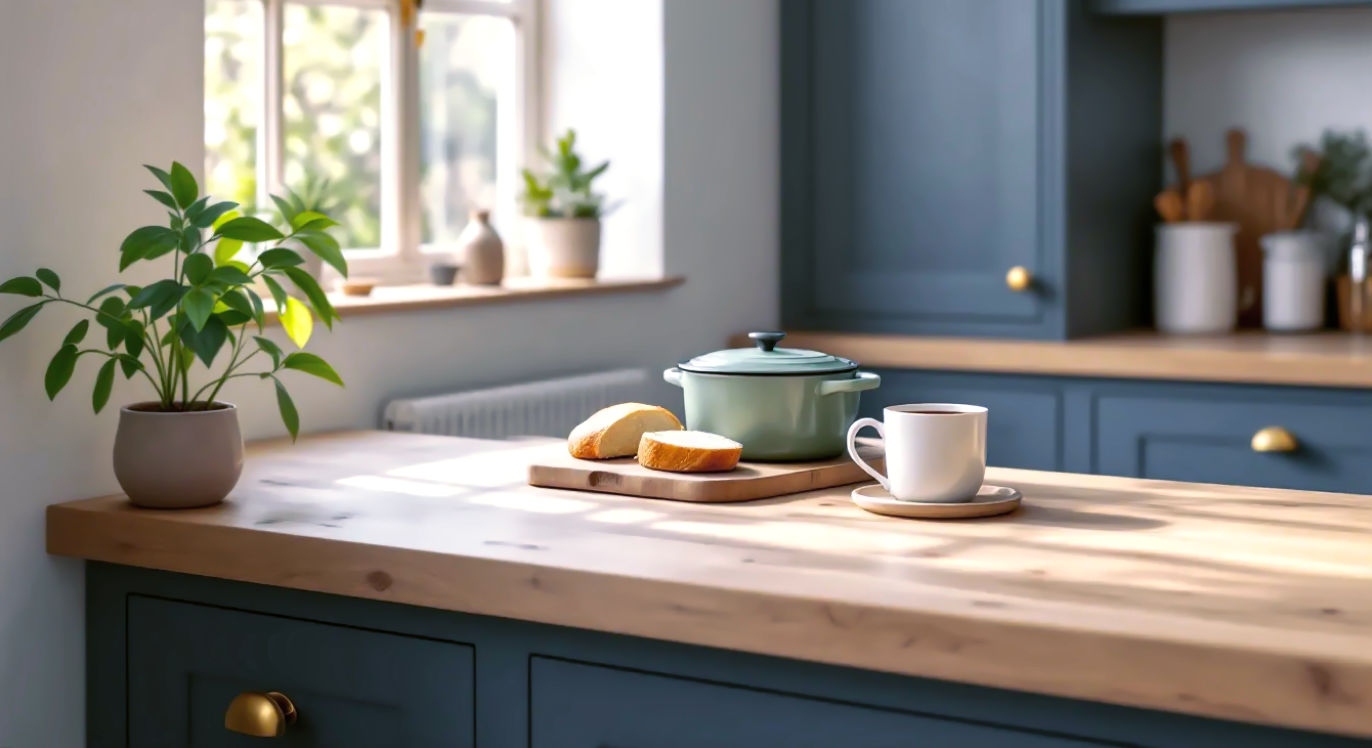Oak Worktops: A Durable and Stylish Addition to Your Kitchen – The Ultimate UK Guide
Discover if a solid oak worktop is right for your kitchen. This ultimate guide covers everything a UK homeowner needs to know, from choosing the best…

This post may contain affiliate links. If you make a purchase through these links, we may earn a commission at no additional cost to you.
There’s something wonderfully honest about a solid oak worktop. It feels warm to the touch, looks better with every passing year, and brings a little piece of the great British outdoors right into the heart of your home. For many, the kitchen is more than just a place to cook; it’s where homework gets done, cups of tea are shared, and life happens. Choosing the right worktop is a big decision, and oak has remained a firm favourite in British homes for centuries. But is it the right choice for you?
You might be wondering if it’s practical. Can it handle the spills, the heat, and the general chaos of a busy kitchen? How much work is involved in keeping it looking its best? And with so many different types and finishes, where do you even begin?
Don’t worry. We’ve got you covered. This is your definitive guide to everything you need to know about oak worktops. We’ll walk you through the different types of oak, help you understand what makes a quality worktop, and give you the straightforward, no-nonsense advice you need to choose, install, and care for one. Think of this as a friendly chat with an expert who wants you to feel confident and excited about your new kitchen. By the end, you’ll understand why this timeless classic might just be the perfect finishing touch for your home.
What’s So Special About Oak, Anyway? A Very British Love Affair
Before we get into the nuts and bolts, let’s take a moment to appreciate why oak holds such a special place in our hearts. Oak trees are woven into the very fabric of Britain. They are ancient, majestic giants that have stood watch over our landscape for thousands of years. From the mighty oaks of Sherwood Forest, legendary home of Robin Hood, to the timber that built the ships of the Royal Navy, this wood is synonymous with strength, endurance, and British heritage.
When you bring oak into your kitchen, you’re not just choosing a piece of wood; you’re choosing a material with a story. Each worktop has its own unique grain pattern, a fingerprint of the tree it came from. The swirling lines and subtle knots tell a tale of seasons passed, of slow, steady growth. This natural character is something that factory-made materials like laminate or quartz just can’t replicate.
Oak has a warmth and charm that makes a kitchen feel instantly welcoming. It works beautifully in a traditional country cottage, adds a touch of rustic elegance to a modern townhouse, and provides a lovely, tactile contrast to sleek, contemporary cabinets. It’s this versatility, combined with its legendary durability, that has made it an enduring choice for generations.
Why Choose a Wooden Worktop in the First Place?
In a world filled with high-tech materials, the appeal of solid wood is stronger than ever. Here’s a quick rundown of what makes it stand out:
- Timeless Beauty: Wood never goes out of style. The rich colours and intricate grain patterns add a natural beauty that enhances any kitchen design.
- Warmth and Character: Unlike cold, hard stone or laminate, a wooden worktop feels warm and inviting. It also has natural antibacterial properties, which is a nice bonus in a food preparation area.
- It Gets Better with Age: While some materials show their age with scratches and stains, a well-cared-for oak worktop develops a rich patina over time. Minor marks and dents simply add to its character, telling the story of your family’s life.
- Repairable and Refinishable: This is a huge advantage. If your worktop gets a deep scratch or a stubborn stain, you don’t have to live with it forever. You can simply sand the area down and re-oil it, making it look as good as new. Try doing that with a chipped laminate worktop!
- Eco-Friendly Choice: When sourced from properly managed forests, wood is one of the most sustainable materials you can choose. We’ll talk more about this later, but look for suppliers who are FSC or PEFC certified to ensure your worktop is an environmentally responsible choice.
Of course, wood isn’t perfect. It requires a bit more TLC than some other materials. You’ll need to oil it regularly, be careful with hot pans, and wipe up spills promptly. But for many people, this small amount of maintenance is a small price to pay for the unrivalled character and beauty of a solid oak worktop.
Understanding the Different Types of Oak Worktop
When you start shopping for an oak worktop, you’ll quickly realise there isn’t just one type. The construction, the grade of the timber, and even where the oak comes from can all affect the look, performance, and price. Let’s break it down into simple terms.
How Oak Worktops Are Made: Staves and Construction
A solid oak worktop isn’t made from a single, giant slab of wood. That would be incredibly expensive and prone to warping. Instead, they are constructed from smaller planks of solid oak called staves. These staves are joined together to create a large, stable, and durable surface. The way these staves are arranged gives the worktop its distinctive look.
Standard Oak Worktops (40mm Staves)
This is the most common and classic style. The worktop is made from staves that are typically around 40mm wide. They run the full length of the worktop, but multiple staves are joined along their width.
- The Look: This construction creates a traditional, blocky pattern that’s full of character. You’ll see a beautiful variation in grain and colour between the different staves, giving it a rustic, butcher’s block feel.
- Best For: This is a great all-rounder. It suits everything from classic farmhouse kitchens to more contemporary designs. It’s also usually the most affordable option.
Deluxe and Super Stave Worktops (60mm-120mm Staves)
These are a more premium option. They are constructed in the same way as standard worktops, but the staves are much wider – anything from 60mm up to 120mm or more.
- The Look: The wider staves create a more luxurious and seamless appearance. There are fewer joints, which allows the long, elegant lines of the oak grain to really shine through. It looks less like a collection of blocks and more like a solid plank of wood.
- Best For: If you have a large kitchen or a long island, the wider staves of a deluxe or super stave worktop can look particularly stunning. They lend a sense of quality and grandeur to the space.
Full Stave Oak Worktops
This is the crème de la crème of oak worktops. A full stave worktop is made from staves that are not only extra-wide (often 80mm or more) but also run the entire length of the worktop.
- The Look: This is as close as you can get to having a worktop made from a single piece of oak. The uninterrupted grain pattern is absolutely beautiful, showcasing the natural elegance of the wood in its purest form. It creates a very high-end, bespoke feel.
- Best For: Full stave is the ultimate choice for a statement kitchen island or a premium kitchen design where you want the natural beauty of the wood to be the star of the show. As you might expect, it’s also the most expensive option.
Understanding Oak Grades: Not All Oak Is Created Equal
The staves used to make a worktop are graded based on their appearance. The grade tells you about the character of the wood – how many knots it has, how much the colour varies, and the overall uniformity of the grain. There’s no “best” grade; it’s all about the look you prefer.
- Prime Oak: This is the highest grade. The wood has a very uniform colour and a relatively straight grain. There will be very few, if any, knots, and those that are present will be small and unobtrusive (usually less than 20mm in diameter). Prime oak has a clean, contemporary, and sophisticated look.
- Natural or Character Oak: This is the most popular grade. It offers a perfect balance between the clean look of Prime Oak and the rustic charm of Rustic Oak. You’ll see more variation in colour and grain patterns, and a natural scattering of knots and other small features like mineral streaks. These knots are generally sound and stable, adding to the authentic character of the wood. This grade gives you that classic, warm, and natural oak look.
- Rustic Oak: If you love wood with a lot of personality, this is the grade for you. Rustic oak is full of character. It features a high number of knots of various sizes, more dramatic colour variations, and a more active, swirling grain. These features tell the story of the tree’s life and give the worktop a wonderfully traditional, farmhouse feel.
A quick tip: Don’t get too hung up on the names. One supplier’s “Natural” might be another’s “Character.” Always look at photos or, even better, a sample to make sure you’re happy with the amount of character in the wood.
Choosing the Right Oak Worktop for Your Kitchen
Now that you understand the different types and grades, how do you choose the right one for your home? Here are a few things to consider.
Match It to Your Kitchen Style
Think about the overall look and feel you want to create.
- For a Modern, Minimalist Kitchen: A Prime Oak worktop, perhaps in a Deluxe or Full Stave construction, would be a perfect choice. The clean lines and uniform appearance will complement sleek, handleless cabinets and simple colour palettes.
- For a Classic or Shaker-Style Kitchen: You can’t go wrong with a Natural Grade worktop in a Standard 40mm Stave construction. It’s the quintessential choice that feels timeless, warm, and welcoming.
- For a Rustic, Country, or Farmhouse Kitchen: Embrace the charm of a Rustic Grade worktop. The knots and characterful grain will look right at home with traditional cabinets, a Belfast sink, and flagstone floors.
Think About Your Budget
As we’ve discussed, the price of oak worktops can vary significantly.
- Most Budget-Friendly: Standard worktops (40mm staves) in a Natural or Rustic grade are generally the most affordable.
- Mid-Range: Deluxe or Super Stave worktops, or a Standard worktop in a Prime grade, will sit in the middle.
- Premium Option: Full Stave worktops in a Prime grade will be at the top end of the price scale.
Remember to factor in the cost of installation, finishing oils, and any accessories like upstands or splashbacks.
Thickness and Profile Edges
There are a couple of other small details to consider.
- Worktop Thickness: Most oak worktops come in a standard thickness of around 27mm or 40mm. The 40mm thickness is more popular as it gives a chunkier, more substantial look and feel. It’s a classic choice that feels solid and durable. A 27mm worktop can work well in smaller kitchens or for a more slender, modern aesthetic.
- Edge Profiles: The edge of the worktop can be shaped in different ways. The standard is a simple square edge, which is clean and modern. For a softer look, you can opt for a rounded or pencil edge. For a more traditional or decorative feel, you could choose a Chamfer or Ogee edge. Most suppliers offer an edge profiling service for a small extra cost.
Where Does the Oak Come From? European vs. American Oak
Most oak worktops sold in the UK are made from European Oak. It’s known for its beautiful, straight grain and warm, honey-toned colour. It’s a very hard and durable wood, making it ideal for kitchen use.
You might occasionally see worktops made from American White Oak. It’s also very strong and durable, but it tends to have a slightly more golden hue and a more pronounced, wavy grain pattern compared to its European cousin.
Honestly, both are excellent choices. The differences are subtle, and your decision will likely come down to personal preference on the colour and grain. The most important thing is that the wood is sourced from sustainable, well-managed forests. Always check for FSC (Forest Stewardship Council) or PEFC (Programme for the Endorsement of Forest Certification) credentials. This is your guarantee that the forest is being managed in a way that protects biodiversity and ensures its long-term health.
Installation: Getting It Right First Time
A solid wood worktop needs to be installed correctly to ensure it lasts a lifetime. Wood is a natural material, and it will expand and contract slightly with changes in temperature and humidity in your kitchen. The installation process needs to allow for this natural movement.
While it’s a job that a confident DIYer can tackle, if you’re in any doubt, it’s always best to hire a professional kitchen fitter who has experience with solid wood. Here are the key steps and considerations.
Acclimatisation: Don’t Skip This Step!
This is absolutely crucial. Before you even think about cutting or installing your worktops, they need to get used to their new home.
- Bring them inside: As soon as they are delivered, bring the worktops into the room where they will be installed.
- Lay them flat: Place them on battens (small pieces of wood) to allow air to circulate freely around all surfaces. Make sure they are supported evenly along their length.
- Leave them for 3-5 days: This gives the wood time to adjust to the temperature and humidity level of your house. Skipping this step is the number one cause of worktops warping or splitting after installation.
Cutting and Fitting
Cutting solid oak requires sharp tools and precision.
- Cut-outs: You’ll need to make cut-outs for your sink and hob. A router and a jig will give you the cleanest and most accurate results. Make sure you follow the manufacturer’s instructions for the appliance, leaving the correct expansion gap.
- Joining Worktops: If you need to join two worktops together (for example, at a corner), you’ll need to use worktop connector bolts and a biscuit joint or similar for alignment. This creates a strong, tight, and almost invisible seam.
- End Caps: It’s a very good idea to fit a solid oak end cap to any exposed end grain (the bit you see at the end of a run of units). This seals the end grain, which is the most vulnerable part of the wood for absorbing moisture, and gives a neat, professional finish.
Fixing to Cabinets: The Importance of Expansion Slots
This is the part that allows for that natural wood movement. You must not screw the worktop directly to the kitchen cabinets.
Instead, you need to use slotted angle brackets. The worktop is fixed to the cabinet using a screw that passes through a slot in the bracket. This holds the worktop firmly in place but allows it to slide ever so slightly as it expands and contracts. This prevents the wood from bowing, cupping, or splitting over time.
You should also leave a small expansion gap (around 3-5mm) between the back edge of the worktop and the wall. This will be hidden by your tiles or upstand.
The Secret to a Beautiful Oak Worktop: Oiling and Finishing
The single most important thing you can do to protect your oak worktop and keep it looking fabulous is to oil it properly. An unoiled worktop is like a sponge – it will soak up any spills, leading to stains and watermarks. Oiling seals the pores of the wood, making it water-resistant and easy to clean.
Choosing the Right Oil
The best choice for finishing a kitchen worktop is a Hardwax Oil. Brands like Osmo Polyx-Oil, Fiddes Hard Wax Oil, or Rustins Worktop Oil are all excellent.
Here’s why Hardwax Oil is so good:
- It’s food-safe: Once cured, it’s perfectly safe for food preparation areas.
- It’s durable and resistant: It creates a hard-wearing finish that is resistant to water, stains, and general wear and tear.
- It’s microporous: This is a fancy way of saying it allows the wood to breathe. It doesn’t create a plastic-like film on the surface.
- It’s easy to apply and repair: You don’t need to be a professional decorator to get a great finish, and if you get a scratch, you can spot-repair it without having to sand the whole thing down.
You might see other oils mentioned, like Danish Oil or Tung Oil. These are also good, but modern Hardwax Oils generally offer the best combination of protection and ease of use for a kitchen environment.
How to Oil Your Worktop for the First Time
Before installation, you need to oil every single surface of your worktop – top, bottom, and all the edges. This creates a complete seal and prevents the wood from warping.
- Prepare the surface: Give the worktop a very light sanding with a fine-grit sandpaper (around 150 grit). This opens up the pores of the wood to help it absorb the oil. Always sand in the direction of the grain. Wipe away all the dust with a clean, lint-free cloth.
- Apply the first coat: Apply a thin, even coat of oil using a lint-free cloth or a good quality brush. Work it into the wood, going with the grain. Don’t let it pool. The aim is a thin, even layer.
- Wipe off the excess: After about 10-15 minutes, use a clean cloth to wipe off any excess oil that hasn’t soaked in. This is important for achieving a smooth, professional finish.
- Let it dry: Leave it to dry completely. This can take anywhere from 8 to 24 hours, depending on the oil you’re using and the conditions in the room. Check the instructions on the tin.
- Apply more coats: Repeat the process. You’ll need to apply at least three coats to all surfaces before installation, and maybe one or two more to the top surface after it’s been installed. For areas around the sink, it’s a good idea to apply an extra coat or two for maximum protection.
Safety first! Oily rags can spontaneously combust. Don’t just throw them in the bin. Lay them flat to dry outside or soak them in water before disposing of them.
Living with Your Oak Worktop: Day-to-Day Care and Maintenance
Once your beautiful new worktop is installed and oiled, keeping it looking great is surprisingly easy. It just requires a little bit of common sense and a few good habits.
Daily Cleaning
- Wipe up spills straight away: This is the golden rule. Don’t let liquids sit on the surface, especially things like red wine, curry, or blackcurrant juice.
- Use a damp cloth and a mild soap: For daily cleaning, a soft cloth dampened with warm water and a tiny bit of washing-up liquid is all you need.
- Avoid harsh chemicals: Never use abrasive cleaners, bleach, or all-purpose sprays. These can strip the oil finish and damage the wood. There are special soaps available from the oil manufacturers (like Osmo Wash and Care) that are designed to clean without harming the finish.
- Dry the surface: After cleaning, give it a quick wipe with a dry cloth, especially around the sink area.
Protecting Your Worktop
- Use chopping boards: Always use a chopping board for cutting. Slicing directly on the oak will score the wood and damage your knives.
- Use trivets for hot pans: Don’t place hot pans or dishes directly onto the worktop. The intense heat can burn the wood and leave a permanent mark.
- Be careful with cast iron: Wet cast iron pans can react with the tannins in the oak and leave a black stain that can be difficult to remove. Make sure they are completely dry before placing them on the surface, and don’t leave them there for long periods.
Re-Oiling and Long-Term Maintenance
Your worktop will tell you when it needs a bit of attention. If you notice that water is no longer beading on the surface and is starting to soak in, it’s time for a top-up coat of oil.
- How often? For the first year, you might need to re-oil it every 3-6 months. After that, once a year is often enough. Areas that get a lot of use, like around the sink, might need it a little more frequently.
- How to do it: The process is simple. Give the worktop a good clean and let it dry completely. Then apply one thin coat of your Hardwax Oil, just like you did when you first installed it. Let it cure, and you’re done. It’s usually a job you can do in the evening and it’ll be ready to use again by morning.
Dealing with Minor Scratches and Stains
This is where wood worktops really come into their own.
- For light scratches: Often, simply rubbing a little bit of oil into the scratch with a cloth is enough to make it disappear.
- For deeper scratches or stubborn stains: Don’t panic! You can easily sand the affected area by hand with some fine-grit sandpaper (always sand with the grain). Feather the edges of the sanded area so it blends in. Then, simply wipe away the dust and re-apply a couple of coats of oil to the patch. It will blend in seamlessly with the surrounding area.
Oak Worktops: The Pros and Cons at a Glance
Let’s quickly summarise the key points to help you decide.
The Pros:
- Stunning Natural Beauty: Adds warmth, character, and a timeless style to any kitchen.
- Durable and Long-Lasting: With proper care, an oak worktop can last for decades.
- Ages Gracefully: Develops a beautiful, rich patina over time.
- Fully Repairable: Scratches and stains can be sanded out and re-finished.
- Hygienic: Oak has natural antibacterial properties.
- Sustainable: A great eco-friendly choice when sourced from certified forests.
- Good Value for Money: Offers a solid wood option that is often more affordable than granite or quartz.
The Cons:
- Requires Regular Maintenance: You need to be prepared to oil it regularly to keep it protected.
- Can Be Scratched or Dented: It’s not as scratch-proof as stone, but it is repairable.
- Vulnerable to Heat and Water Damage: You need to be careful with hot pans and standing water, especially around the sink.
- Requires Correct Installation: Needs to be installed properly to allow for natural wood movement.
Final Thoughts: Is an Oak Worktop Right for You?
An oak worktop is more than just a surface; it’s an investment in your home. It’s a choice for people who appreciate the beauty of natural materials and are willing to put in a little bit of care to help it look its best.
If you’re looking for a completely maintenance-free option that you can treat with reckless abandon, then oak probably isn’t for you. A laminate or a quartz worktop might be a better fit.
But if you love the idea of a worktop that has a story to tell, that feels warm and alive under your hands, and that will grow more beautiful with every year that passes, then you will absolutely fall in love with oak. It’s a piece of furniture for your kitchen, a backdrop to your daily life that is both practical and beautiful. By following the simple care and maintenance advice in this guide, you’ll have a worktop that you and your family will enjoy for many, many years to come.
Further Reading & Reputable UK Resources
To continue your research, here are some highly respected UK-based companies and resources known for their expertise in solid wood worktops:
- Worktop Express: One of the UK’s largest online suppliers, offering a huge range of wood types, sizes, and a wealth of information on their blog.
- Howdens: A trade supplier with showrooms across the UK, known for their quality kitchen components, including solid oak worktops.
- Benchmarx: Another reputable trade supplier, part of the Travis Perkins group, offering a good selection of quality wooden worktops.
- Osmo UK: The official site for Osmo oils, providing detailed technical data sheets and application guides for their industry-leading finishing products.






